(Forthcoming in the Herald-Citizen)

Passed by many in Danvers each day, the blue memorial marker on the street sign for Lane Parkway near the Holten-Richmond Middle School stands in remembrance of a Danvers veteran: Lt. Ralph W. Lane, who died defending the United States in World War I. During the war, 730 men from Danvers entered the service, and 15 were killed either in combat or from the flu pandemic that ravaged military bases.
Born in Springfield in 1894, Ralph Lane later attended Worcester Academy and the University of Maine before moving to Danvers in 1911. A single man in his early twenties who was new to town, Lane lived in a boardinghouse at 20 Lawrence Street and was very active in the community. He was a member of the Maple Street Congregational Church and several clubs and bible study groups associated with the church, along with the Amity Lodge of the Danvers Masons, and the Danvers I.O.O.F.
Lane served in the Massachusetts state militia and was briefly deployed to the Mexican border in 1916 as part of an expedition sent to capture Mexican revolutionary Pancho Villa, who had led an army across the border and attacked New Mexico. After this campaign, Lane returned to Danvers and was appointed drill instructor at the state armory on Essex St. in Salem.
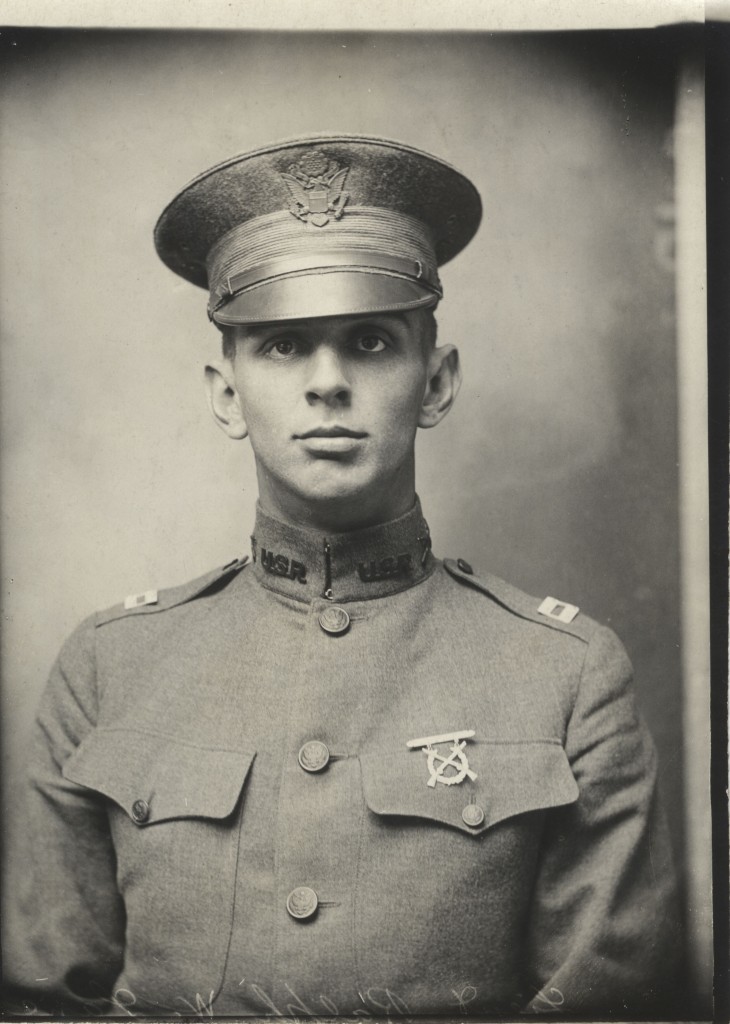
Once it became clear in 1917 that the US would likely join the ongoing world war, Lane’s state militia unit was federalized into the National Guard. Promoted to second lieutenant in August 1917, Lane and his regiment were under the command of Col. (later Major General) Edward Lawrence Logan, for whom Logan Airport was named, and were assigned to the newly-formed 26th Infantry Division in September 1917. Known as the “Yankee Division” because it was made up of New England National Guard units, the 26th Infantry Division is the namesake for Route 128: “The Yankee Division Highway.”
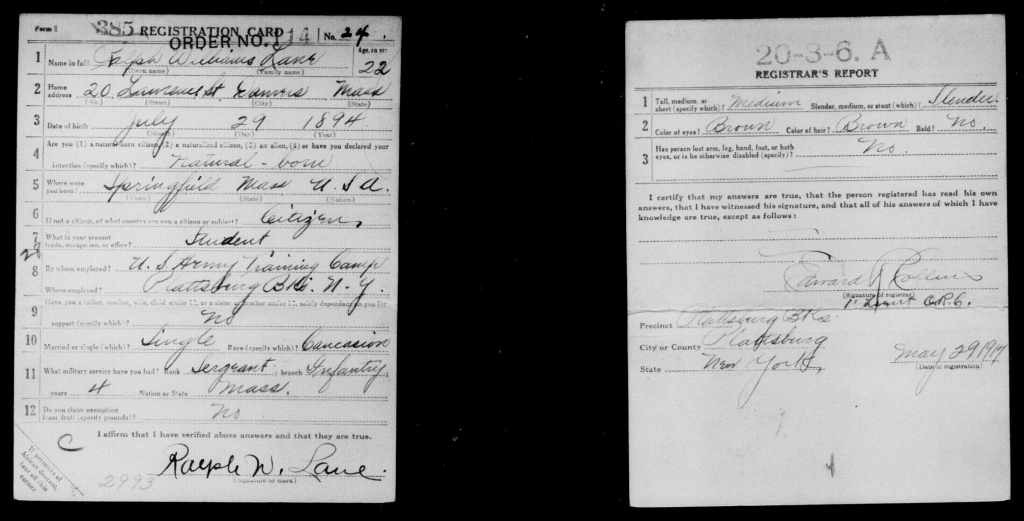
Arriving in France as the first unit of the National Guard deployed overseas, Lane and the Yankee Division trained with the French army to learn trench warfare techniques before entering the front line in February 1918 along the Western Front under the command of a French army corps. As soon as the Germans realized that Americans were in the line for the first time, there was a heavy German offensive in the area to try and break these new arrivals, but the line held.
That summer, Lane and the Yankee Division fought to slow the Germans’ spring offensive. While fighting along the Marne River, the Germans used poison gas against Lane’s position on the front line, causing him to be seriously hurt and hospitalized.
In a bizarre twist, when Lane was recovering in an Army field hospital, he encountered another Danvers man who served on a different section of the front with a field artillery regiment: Corp. Harold P. Sillars. Not only were these two men from Danvers, but they were friends who lived in the same boardinghouse on Lawrence Street! This unique “joyous reunion” was noteworthy enough to be mentioned in the Boston Globe.
By October, Lane was back with his unit to participate in the Meuse-Argonne Offensive, the final push that ended in the armistice of November 11, 1918. But, he never lived to see the Allied victory.
The Yankee Division was along the front line north of Verdun, near Belleau-Bois just below the French-Belgian border. This area was desolate, charred, and cratered land that had been destroyed during the Battle of Verdun two years prior, and known as “Death Valley” to the troops. The Yankee Division, as one of the most experienced American units in France – which previously survived bullets whizzing overhead, charges of German shock troops, constant shelling, mud, rats, and poison gas – was given the task of fighting through difficult hills and ravines in this wooded region of the front.
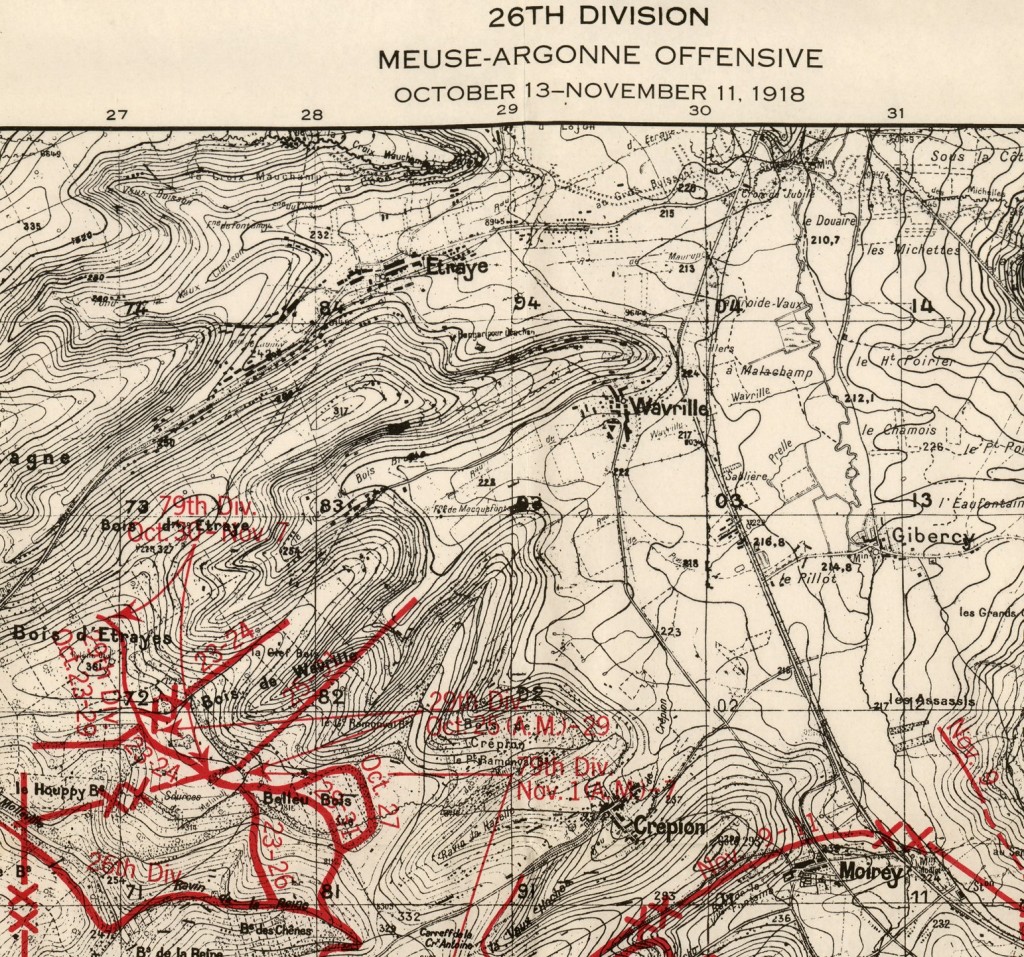
As the offensive began in other sectors, Lane and the Yankee Division assaulted Belleau, a wooded ridge alongside the road to the village of Crépion. They advanced into the wood on the 23rd, had to withdraw that night due to heavy shelling, and then advanced 500 yards on the 24th starting the attack under a smokescreen, at which point they encountered fortified German positions of timber and concrete. Four times that day the Germans withdrew, called in heavy artillery on the Americans, and then the moment the shelling ceased, charged the American line inflicting heavy casualties.
After a full day of brutal fighting, at 2:30am the next day, October 25, the Yankee Division charged back into the woods, in the pitch dark and pouring rain, as German shells fell around them. They took the wooded hill, but Lane was killed – only 18 days before the end of the war, and only three miles from where the front line ended up on Armistice Day.
On December 8, 1918 Lane’s obituary ran in the Boston Globe, alongside a large list of Massachusetts men reported killed overseas. The Globe noted his father John S. Lane as his only surviving relative. Back home in Danvers, the Maple Street Church held a memorial service on February 9, 1918 for Lane and Sgt. Hadley McPhetres, two members of its congregation who died in the war. This was the closest thing to a funeral that Lane ever received.
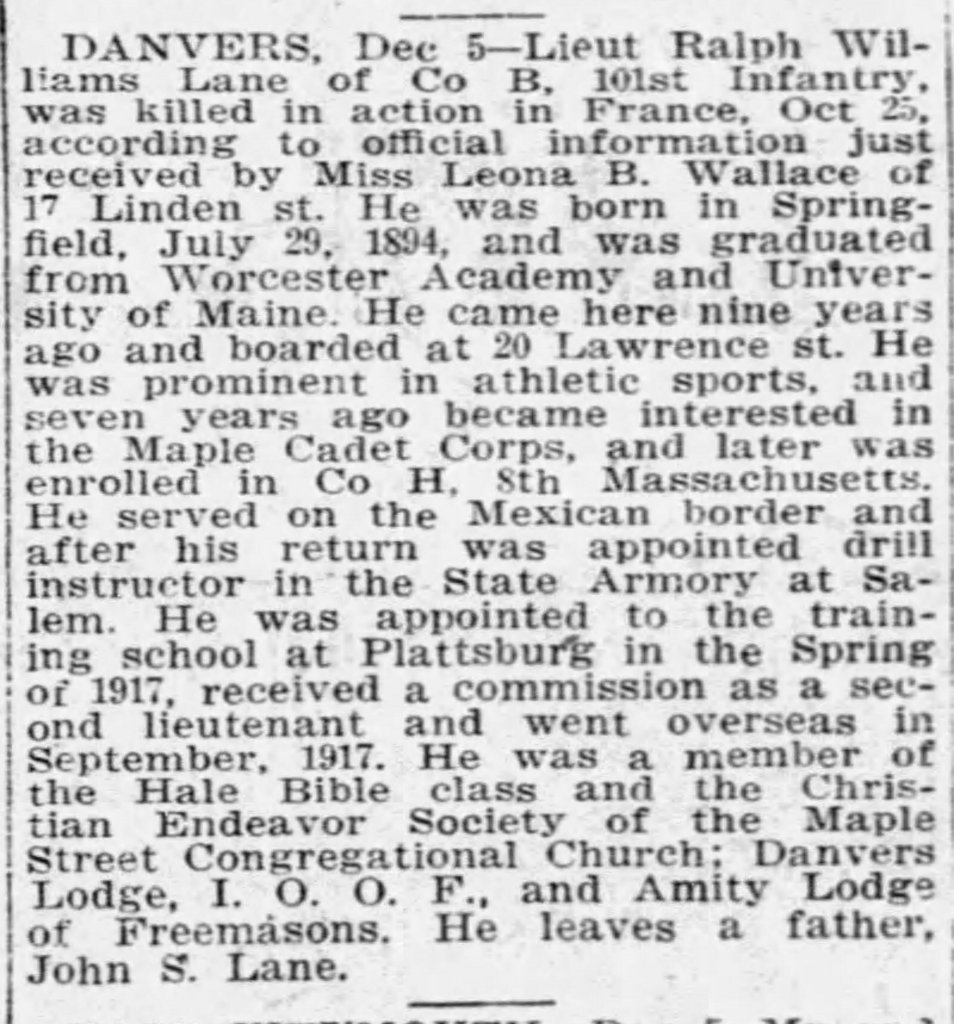
Lane Parkway’s memorial sign, dedicated November 11, 1929, notes Lane’s death on that October night, and the Army records likewise note his death that day, but he has no grave. According to the American Battle Monuments Commission that oversees the American cemeteries in France, Lane’s remains were either never recovered or never identified, and therefore his name is inscribed on the “Tablets of the Missing” at the Meuse-Argonne American Cemetery in France. Closer to home, the sign on Lane Parkway keeps his memory alive.
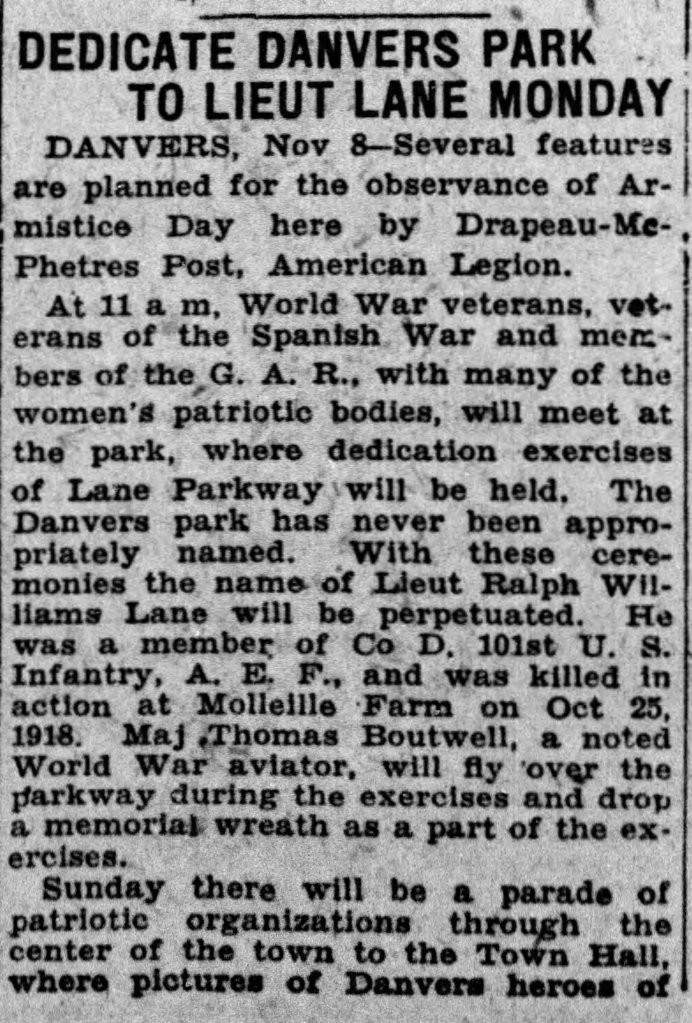
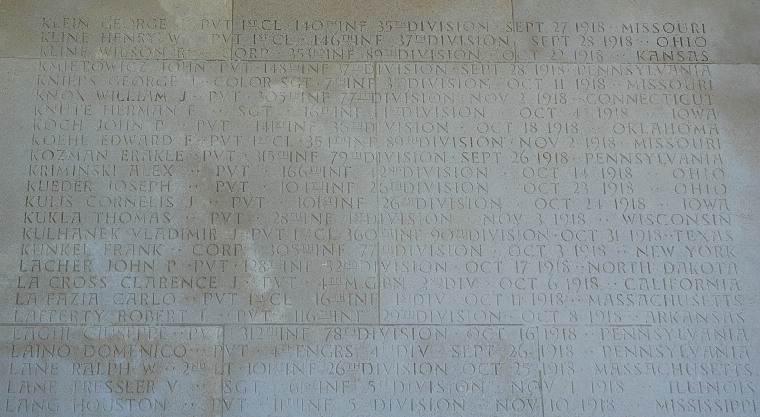
—————————————————————————————————————-
“Airplane Drops Wreath at Danvers Dedication.” Boston Globe, November 12, 1929. Boston Globe Archive. http://bostonglobe.newspapers.com/image/431193458/?terms=ralph%2Blane%2Bdanvers.
American Battle Monuments Commission. 26th Division Summary of Operations in the World War. Washington, DC: U.S. Government Printing Office, 1944. http://hdl.handle.net/2027/mdp.39015051180605.
“Dedicate Danvers Park to Lieut. Lane Monday.” Boston Globe, November 8, 1929. Boston Globe Archive. http://bostonglobe.newspapers.com/image/431182143/?terms=ralph%2Blane%2Bdanvers.
“Eight Infantry.” Boston Globe, January 9, 1916. Boston Globe Archive. http://bostonglobe.newspapers.com/image/430938131/?terms=ralph%2Bw%2Blane.
Forman, Ethan. “Danvers Veterans’ Squares Get New Plaques.” Salem News, May 4, 2017. https://www.salemnews.com/news/local_news/danvers-veterans-squares-get-new-plaques/article_6ae3f460-be41-5d0c-ad99-21ce23eb7e18.html.
Globe Newspaper Company. Photograph of Lieut. Ralph W. Lane, 101st Infan. 1917. Massachusetts State Library. https://archives.lib.state.ma.us/handle/2452/211551.
“Lieut. Ralph Williams Lane (Obituary).” Boston Globe, December 6, 1918. Boston Globe Archive.
“Lifelong Chums Meet in French Hospital.” Boston Globe, September 5, 1918. Boston Globe Archive.
American Battle Monuments Commission. “Lt. Ralph W. Lane Memorial Certificate.” Accessed October 29, 2020. https://www.abmc.gov/print/certificate/291473.
“Nine of 17 New Majors Made At Plattsburg Are Boston Men.” Boston Globe, August 11, 1917. Boston Globe Archive.
Palmer, Frederick. Our Greatest Battle: The Meuse-Argonne. New York: Dodd, Mead, and Company, 1919.
“Plattsburg Men Join 26th Division.” Boston Globe, September 2, 1917. Boston Globe Archive.
American Battle Monuments Commission. “Ralph W. Lane.” Accessed October 29, 2020. http://www.abmc.gov/decedent-search/lane%3Dralph.
FamilySearch. “Ralph Williams Lane, ‘United States, Veterans Administration Master Index, 1917-1940.’” Accessed October 29, 2020. /ark:/61903/1:1:W3CV-9TN2.
“Salem Church Honors Memory of Two Soldiers.” Boston Globe, February 10, 1919. Boston Globe Archive.
Tapley, Harriet S. Chronicles of Danvers (Old Salem Village), Massachusetts, 1632-1923. Danvers, Mass.: The Danvers Historical Society, 1923.
Tuoti, Gerry. “Danvers Residents Remembered for Efforts during World War I.” Taunton Gazette, April 6, 2017. https://www.tauntongazette.com/news/20170406/danvers-residents-remembered-for-efforts-during-world-war-i.
“United States World War I Draft Registration Cards, 1917-1918,” database with images, FamilySearch (https://familysearch.org/ark:/61903/3:1:33S7-9BRN-C17?cc=1968530&wc=9FH6-T3X%3A928311301%2C928801701 : 24 August 2019), Massachusetts > Peabody City no 26; A-Mazurkiewicz, Witold > image 3860 of 4811; citing NARA microfilm publication M1509 (Washington, D.C.: National Archives and Records Administration, n.d.).
War Department – Office of the Quartermaster General. Graves Registration Service. “Card Register of Burials of Deceased American Soldiers,” 1922 1917. National Archives Identifier: 6943087. National Archives at College Park – Textual Reference(RDT2). https://www.familysearch.org/ark:/61903/3:1:33S7-9BRN-C17?i=3859&cc=1968530&personaUrl=%2Fark%3A%2F61903%2F1%3A1%3AKZNF-BNK.
War Department – The Adjutant General’s Office. Massachusetts World War I, Dead, A.E.F. Series: Compiled Data on Casualties of the American Expeditionary Forces by State or
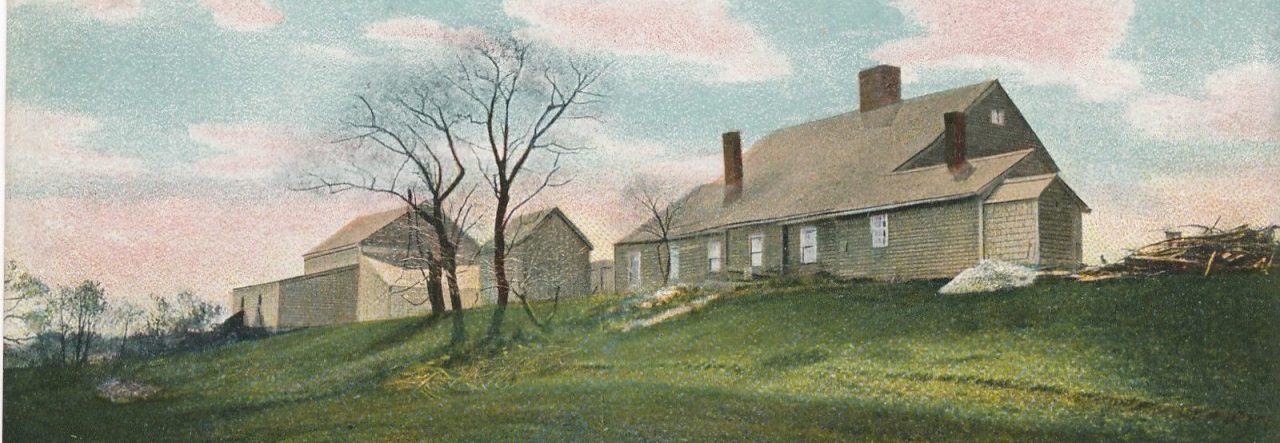
I find your historical findings most interesting and informative, keep up the good work
Edmund Kowalski
E.kowalski@verizon.net
Sent from my iPad
>
LikeLike
Thank you!
LikeLike